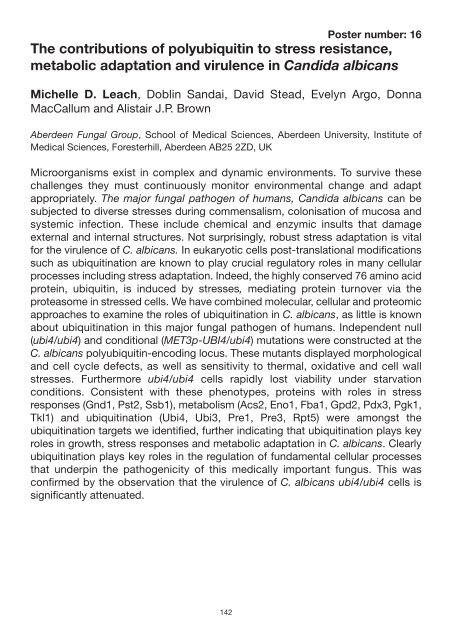Candida Infection Biology – fungal armoury, battlefields ... - FINSysB
Candida Infection Biology – fungal armoury, battlefields ... - FINSysB
Candida Infection Biology – fungal armoury, battlefields ... - FINSysB
Create successful ePaper yourself
Turn your PDF publications into a flip-book with our unique Google optimized e-Paper software.
Poster number: 16<br />
The contributions of polyubiquitin to stress resistance,<br />
metabolic adaptation and virulence in <strong>Candida</strong> albicans<br />
Michelle D. Leach, Doblin Sandai, David Stead, Evelyn Argo, Donna<br />
MacCallum and Alistair J.P. Brown<br />
Aberdeen Fungal Group, School of Medical Sciences, Aberdeen University, Institute of<br />
Medical Sciences, Foresterhill, Aberdeen AB25 2ZD, UK<br />
Microorganisms exist in complex and dynamic environments. To survive these<br />
challenges they must continuously monitor environmental change and adapt<br />
appropriately. The major <strong>fungal</strong> pathogen of humans, <strong>Candida</strong> albicans can be<br />
subjected to diverse stresses during commensalism, colonisation of mucosa and<br />
systemic infection. These include chemical and enzymic insults that damage<br />
external and internal structures. Not surprisingly, robust stress adaptation is vital<br />
for the virulence of C. albicans. In eukaryotic cells post-translational modifications<br />
such as ubiquitination are known to play crucial regulatory roles in many cellular<br />
processes including stress adaptation. Indeed, the highly conserved 76 amino acid<br />
protein, ubiquitin, is induced by stresses, mediating protein turnover via the<br />
proteasome in stressed cells. We have combined molecular, cellular and proteomic<br />
approaches to examine the roles of ubiquitination in C. albicans, as little is known<br />
about ubiquitination in this major <strong>fungal</strong> pathogen of humans. Independent null<br />
(ubi4/ubi4) and conditional (MET3p-UBI4/ubi4) mutations were constructed at the<br />
C. albicans polyubiquitin-encoding locus. These mutants displayed morphological<br />
and cell cycle defects, as well as sensitivity to thermal, oxidative and cell wall<br />
stresses. Furthermore ubi4/ubi4 cells rapidly lost viability under starvation<br />
conditions. Consistent with these phenotypes, proteins with roles in stress<br />
responses (Gnd1, Pst2, Ssb1), metabolism (Acs2, Eno1, Fba1, Gpd2, Pdx3, Pgk1,<br />
Tkl1) and ubiquitination (Ubi4, Ubi3, Pre1, Pre3, Rpt5) were amongst the<br />
ubiquitination targets we identified, further indicating that ubiquitination plays key<br />
roles in growth, stress responses and metabolic adaptation in C. albicans. Clearly<br />
ubiquitination plays key roles in the regulation of fundamental cellular processes<br />
that underpin the pathogenicity of this medically important fungus. This was<br />
confirmed by the observation that the virulence of C. albicans ubi4/ubi4 cells is<br />
significantly attenuated.<br />
142


